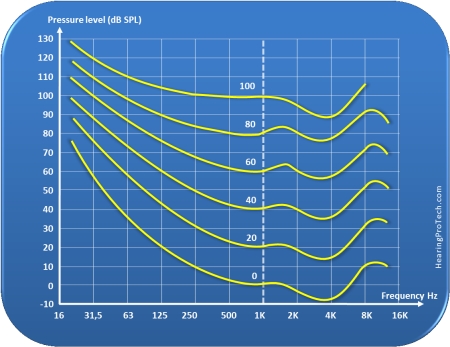Our ear perceives higher frequencies (between 1 and 5 KHz) with much greater sensitivity than low frequencies. This natural resonance of our external ear’s conical shape amplifies acute noise from 10 to 15 dB on average.
Equal-loudness contours
In 1933 Fletcher and Munson measured the changes in our perception of the different frequency bands. The study was to make subjects listen to pure tones at a reference frequency of 1000 Hz. Each subject had to indicate the sound level at which he perceived a sound intensity equivalent to other frequencies. The intensity of the reference frequency was then incremented by 10 decibels. Given the considerable subjectivity of the test, several thousand subjects participated in the study to obtain a representative average.
The result of this study was represented in the form of equal-loudness contours (measurements of sound pressure in decibels, depending on the frequency that a person perceives as sound at the same level), which were used to characterize the sensitivity of the human ear at all frequencies.
In 1956, Robinson and Dadson implemented new measures that were considered more accurate, and served as a reference to the ISO226 standard. In 2003, the ISO226 standard was updated using several studies by Japanese, German, Danish, British, and North American researchers.
Equal loudness contours according to ISO226. Measurements of sound pressure in decibels, based on the frequency that a person perceives as sound at the same level.
The acoustic reflex
A reflex whose role is to protect the inner ear from excessive loudness. The stapedius muscle, which acts on the stapes (a bone in the middle ear which enables the transmission of tympanic vibrations to the inner ear), contracts and thus makes the system more inflexible, which then acts as a protection system against noise.
When the acoustic reflex is triggered, any increase in the perceived sound is attenuated, and thus an increase of 10 dB will cause only a transmission increased by 3dB to the inner ear. The reflex essentially attenuates low frequencies (<2 KHz). It is ineffective on high frequencies.
However, like all muscles, the stapedius becomes tired, and this fatigue occurs more so as the noise level is increased.
At 121dB, it relaxes after 7 seconds (risk of irreparable damage).
At 109 dB, it relaxes after about 1 minute 52 seconds.
At 100 dB, it relaxes after about 15 minutes on average.





